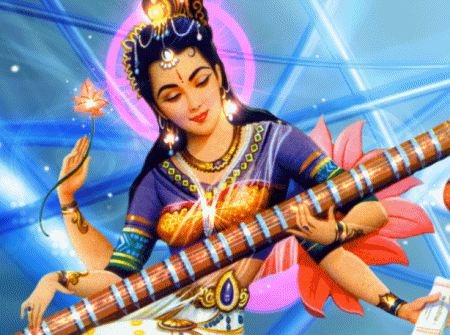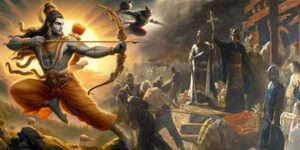Like the unique Vedanta philosophy, the ancient yet vibrant Sanskrit language, the all-encompassing system of Yoga, Indian music is yet another exercise of the Indian mind in its path of exploration into the mysteries of Nature and of Ultimate Truth.
The word Bharata (India) – which is condensed out of the musical expression Bhava, Raga and Tala, rightly emphasises the inalienable relationship between the thoughts, words and actions of human life, and music in India. On one side, it can be said that it is the music within, the Sat-Chit-Ananda (Existence-Knowledge- Bliss Absolute) that finds manifold expressions outside in man’s life. Viewed from the other side, it is the sublimation of actions, words and thoughts that lead one to hear the same music within.
Sound as the Source of Creation
 In India, music is considered as a subtle divine thread capable of linking the Jeevatman (individual soul) with the Parmatman (Supreme Soul), a concept originating in the Tantric idea of Sabdabrahman, the primeval source of creation. This idea finds expression in the eloquent words of the renowned violinist Yehudi Menuhin, ‘Indian music reflects Indian life having no predetermined beginning or end but flowing without interruption through the fingers of the composer-performer.’
In India, music is considered as a subtle divine thread capable of linking the Jeevatman (individual soul) with the Parmatman (Supreme Soul), a concept originating in the Tantric idea of Sabdabrahman, the primeval source of creation. This idea finds expression in the eloquent words of the renowned violinist Yehudi Menuhin, ‘Indian music reflects Indian life having no predetermined beginning or end but flowing without interruption through the fingers of the composer-performer.’
To fully understand the beauty, depth and elevating qualities of Indian music, one must therefore understand, if not experience, these concepts at least to some extent.
It is believed that the Supreme Being is of the nature of Sabdabrahman or Nadabrahman. This Ultimate Sound Principle gets manifested as its vibrations. Through the Samyoga and Viyoga i.e. the union and separation of these vibrations, Sabdabrahman creates the world of ‘forms’, from the sub-atomic to the biggest and the mightiest! The entire cosmos is the manifestation of Sabdabrahman. That being so, in uniting the entire creation, lies ‘Naada’. As the Naada evolves, differentiates and expands from the subtle to the gross, it gives rise to articulate sounds- ‘Varnas’, ‘Srutis’ and ‘Swaras’ – and moves on to create ‘Ragas’, capturing the ‘Bhavas’ (moods) of the mind. From Varnas arise by permutations and combinations, the world of ‘forms’.
Today scientific substantiation of these concepts has been forthcoming through the experimental demonstration that different geometrical figures can be produced by manipulating sound! That means it is possible to reduce all ‘physical forms’ to ‘sound forms’ and vice-versa. In other words, form is sound made manifest. According to the Tantras there are 50 basic sounds out of which the world of forms has come into being.
Classification of Sabda or Sound
 Nowhere in the world has the science of Sound and Music been studied so deeply and exhaustively as in ancient India. Panini, Patanjali, Bhartruhari, Nandikeswara, Anjaneya and Bharata are outstanding among those who have contributed to the unravelling of the mystery of sound, music and creation. The ‘Sabda’ itself is classified into Para, Pashyanti, Madhyama and Vaikhari.
Nowhere in the world has the science of Sound and Music been studied so deeply and exhaustively as in ancient India. Panini, Patanjali, Bhartruhari, Nandikeswara, Anjaneya and Bharata are outstanding among those who have contributed to the unravelling of the mystery of sound, music and creation. The ‘Sabda’ itself is classified into Para, Pashyanti, Madhyama and Vaikhari.
1.The grossest of these four is Vaikhari, the dense audible sound.
2. Madhyama is the stage where thought takes the form of sound or word.
3. Pashyanti is the preceding stage where ‘thought’ assumes a ‘form’ where sound vibration becomes ‘visible’ in the mind. At that stage, there is no impress of language on the form. That is, here the barrier of language has no meaning.
4. Beyond it lies the subtlest, highest and most transcendental stage of Para where neither thought, nor names nor forms find a place, as there are neither waves nor wavelengths there. It is the ultimate unifying substratum – the undifferentiated, yet potential sound of Sabdabrahman. This is the stage of Godhead – sans thought, sound or form, the goal of deep meditation.
No wonder that such a concept and understanding of music developed into a form of worship (Nadopasana) and has carried many on its wings to self-unfoldment and merger with the Ultimate Truth or Parabrahman. From the unmanifest to the manifest, from the manifest to the unmanifest, thus goes the cycle of Naada (sound), stretching from Eternity to Eternity – linking everything without any distinction of desa-kala-nama-roopa (place, time, name, form). Only in the land of Nataraja (cosmic dancer; Shiva), Saraswati (goddess of learning), the Veena (stringed musical instrument), Murali (flute), could such a sublime concept have been conceived, creating a vibrant life, science and tradition in music.
Sri Ramakrishna Paramhansa had beautiful visions bearing on this principle. He used to see a long white thread proceeding out of himself.
‘This mass would open and within it he would see the Mother with a Veena. Then, she would begin to play and as she played he would see the music turning into birds and animals and worlds and arrange themselves. Then she would stop playing and they would all disappear. The light would grow less and less distinct till it was just a luminous mass, the string would grow shorter and shorter and the whole world would be absorbed into himself again.’
What an incomparable vision! A condensed drop of the entire philosophy of sound and music.
From where and how did Indian music originate?
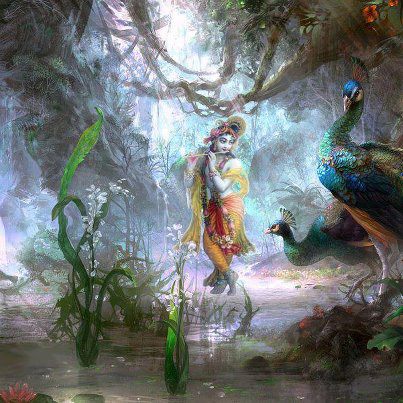 Our ancient seers living in communion with Nature must have ‘seen’ and heard the music in myriad ways and forms. In the rising sun, in the light of the stars, in the heights of the snow-clad Himalayas, in the thick forests, in the thundering clouds, in the gurgling Ganges – in the cries of birds and animals, in the blooming of flowers, dropping of petals, ripening and sweetening of fruit, in birth, growth and decay of created beings, anywhere and everywhere, they would have felt the resonance of the one Naada.
Our ancient seers living in communion with Nature must have ‘seen’ and heard the music in myriad ways and forms. In the rising sun, in the light of the stars, in the heights of the snow-clad Himalayas, in the thick forests, in the thundering clouds, in the gurgling Ganges – in the cries of birds and animals, in the blooming of flowers, dropping of petals, ripening and sweetening of fruit, in birth, growth and decay of created beings, anywhere and everywhere, they would have felt the resonance of the one Naada.
Capturing this music in Nature, they must have felt their souls ringing in harmony with them and instinctively realised the same Naada vibrating within them. With joy and thrill, they must have picked up the basic notes and built around them their grand repertoire:
SA -from the cry of the peacock with its two sounds of lower and higher pitches
RE -from the cry of the bull
GA-from that of a goat
MA-from the cry of the Krauncha bird
PA-from the voice of the Koel in spring
DHA- from the neighing of the horse, and
NE-from the cry of the elephant.
 It is said that Lord Shiva in his cosmic dance produced from his Damaru various types of sounds and the great saint, Patanjali, grasped them in his Maheshwara Sutras and explained the formation of the universe. According to this view, the origin of the 7 basic notes can be traced back to Shiva.
It is said that Lord Shiva in his cosmic dance produced from his Damaru various types of sounds and the great saint, Patanjali, grasped them in his Maheshwara Sutras and explained the formation of the universe. According to this view, the origin of the 7 basic notes can be traced back to Shiva.
According to some others, the 7 keynotes, which form the units of music all over the world, personify 7 levels of human consciousness. Out of this consciousness springs forth the stream of life, essentially consisting of one’s aspirations to reach that sanctum of happiness, bliss and fulfilment within. In a particular direction, it is called music, in another, dance, in a third, painting, in a fourth, poetry. But among all the fine arts, the finest is indeed music. One, who has understood Naada as the very basis of music, realises it as the subtlest of vibrations, which forms the life-current in each and every cell in his body. It is this omnipresent Naada, which, following particular rhythms, curves and waves, flows through our life, enriching us with experiences. If one tries to discover it within and manifest it without, it becomes the fittest musical instrument in the hands of the Supreme and his life itself turns into a music with a rare melody of tune and rhythm.
Sound used in Spiritual Practice or Upasana
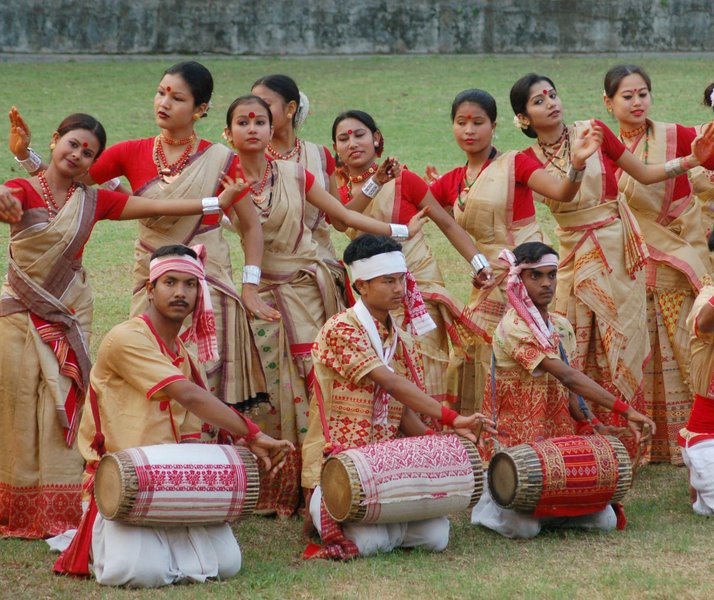 The study of Indian music has its own practical lessons to impart to our every day life. To learn music is a discipline in itself, controlling one’s body, breath, voice, one’s very nature itself. In childhood, learning music helps one to develop a rhythm and order in his daily activities.
The study of Indian music has its own practical lessons to impart to our every day life. To learn music is a discipline in itself, controlling one’s body, breath, voice, one’s very nature itself. In childhood, learning music helps one to develop a rhythm and order in his daily activities.
Through Upasana of naada, he catches glimpses of the unity in diversity. In the second stage, by enriching the Bhavana (feeling) in the music, one can control and sublimate the emotions of the mind. As the evening of life approaches, music turns into a source of peace and joy. Equanimity and tranquillity of mind come as by-products of an advanced musical mind. If one is a true Upasaka (earnest student), before long, from the outer music he will turn towards the inner and start enjoying the subtlest of music – the Anahata Naada, the soundless sound – in the innermost chamber of one’s heart. Thus, music can truly form the vehicle to take man from the gross to the subtle, from the finite to the infinite. As his life’s vibrations become attuned to the divine, his soul’s music reveals to him the music in the creation and of the creation. He finds the entire universe resounding with the Eternal notes – Soham Soham.
The chords of life can be tuned properly as in a musical instrument with self-effort. If one masters this art of tuning, and brings out the best of Swaras without any Apaswaras, then his life becomes attuned to the Supreme Music and he would sing the soul-stirring music of love, compassion and understanding.
Veenaavaadana tatwajnaha;
swarajnaana vishaaradah;
Talajnachaaprayatnena;
param brahmaadhigacchati
“One who plays the Veena with full knowledge of the basic principles of sound, the science of tune evolution 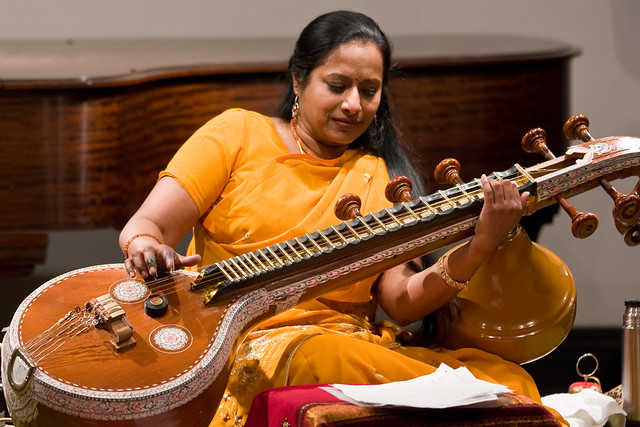 and the beat of music could attain Parabrahman without much effort.”
and the beat of music could attain Parabrahman without much effort.”
There is no aspect of life where music cannot play its role. The soothing of the nerves and the calming of the mind that music brings about are marvellous. Just as a mother can sing her child to sleep through her lullabies, at every context in life, whether in the farms or factories, in games or studies, music can bring in a sense of unity and harmony. In India, we have established long long back, that through proper combinations of Swaras we can create Ragas, which have the capacity to call forth forces of Nature such as the rain, fire, etc. Stones can be melted, glass can be broken, and lamps can be lighted. Trees and plants can respond to the music of one who has attuned himself to the Eternal vibrations.
The Glory of Indian Music
Today, Indian music has caught the attention of musicologists, scientists and other learned men. With more and more research in the field of Indian musicology, more and more hidden treasures are surfacing. In spite of all the ups and downs it has gone through the several centuries of its growth, Indian music has retained its highly aesthetic and elevating spirit and its unique individuality.
Rightly has Shakespeare said of music:
“The man that has no music in himself, nor is moved with sweet concord of sweet sound, is fit for treason, stratagems and spoils.”
Nearer home, we have the Lord Himself proclaiming:
Naaham vasaami Vaikunthe,
Na yogi hriday gaavati
Madbhakta yatra gaayanti
Tatra tishthami Naarada
“I dwell not in Vaikunth (heaven), nor in the hearts of Yogins, nor in the sun; but where my devotees sing, there, O Narada, do I reside.”
That is the uniqueness of Indian music. May that all-pervading Nadbrahman, remove all the Apaswaras (discordant tunes) from our lives and fill it with pleasing, unifying and harmonising Swaras so that the music of our lives may flow melodiously, taking us from untruth to Truth, from darkness to Light, from death to Immortality.
By Dr. M. Lakshmikumari
(Served as president of Vivekananda Kendra, India)
From ‘Jyoti’ magazine
Published by The Ramakrishna Centre of South Africa

